
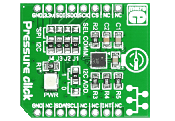
|
Pressure click Released

Pressure Click is a compact and easy solution for adding pressure measurement to your design. It features the LPS331AP digital output pressure sensor. The LPS331AP IC is an ultra compact absolute piezoresistive pressure sensor capable of measuring pressure (260-1260 mbar) or temperature (-40°C to 80°C) and provides a digital signal output to your microcontroller. Pressure Click communicates with the target board microcontroller via mikroBUS SPI (MOSI, MISO, SCK, CS), I2C (SDA, SCL) and INT lines. The board is designed to use a 3.3V power supply only.
|
2013/04/11 |


|
Currency Conversion

As a convenience to international customers, we have begun implementing automatic currency conversion on our site. To try it out, please click here.
|
2013/04/08 |

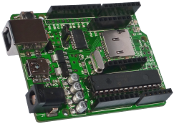
|
Breeze A with PIC18F25K22

We are now also selling our Breeze A boards with a PIC18F25K22 (capable of operating at both 3.3V and 5V).
|
2013/04/05 |


|
USB Host Library for PIC32

mikroElektronika have released a new USB Device (Host) library for the PIC32 microcontrollers, supported by their mikroC, mikroBasic and mikroPascal for PIC32 compilers. Whereas the compilers already include a library for using the USB Slave capabilities of the MCU, this new library facilitates the use of the MCU as a USB Host device - for functionality such as logging data to flash drives, reading keystrokes from USB keyboards, etc.
|
2013/03/28 |

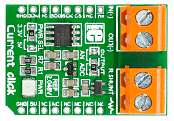
|
Current click Released

Current Click is an add-on board used for the measurement of electric current. It features an INA196 current shunt monitor, MCP3201 12-bit ADC, MAX6106 voltage reference as well as two screw terminals. The board receives current from the output circuit connected to IN(+) and OUT(-) pins of the first screw terminal connectors. INA196 IC converts this current into a voltage. The second screw terminal is used for external shunt. In order to measure current values in various bands, you need to provide the shunt of the appropriate value. Four shunts with different values are provided in the package. Current Click communicates with the target microcontroller via mikroBUS SPI or AN lines. The board is designed to work with either a 3.3V or 5V power supply.
|
2013/03/08 |


|
8x8 click with Blue LEDs

8x8 click, which is already available in red, green and yellow LEDs, is now available in blue LEDs as well.
|
2013/03/08 |

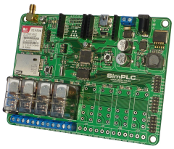
|
SimPLC on Pre-Release

Our SimPLC board is now available on pre-release.
|
2013/02/18 |

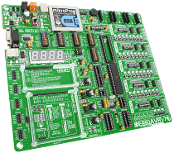
|
EasyAVR7 Released

The EasyAVR7 is a development tool for DIP-package Atmel AVR microcontrollers. Some of it's features include LEDs, buttons and headers connected to each MCU pin, an on-board USB 2.0 programmer, 3 mikroBus sockets for easily connecting "click" accessory boards, RS-232, USB-UART and LCD, GLCD and 7 segment displays.
|
2013/02/18 |


|
BlueTooth2 click Released

Bluetooth2 Click features the BLUEGIGA WT41 Bluetooth 2.1 module with an operating range of 1000m (between two WT41 modules). It is equipped with iWRAP firmware which enables users to access Bluetooth functionality with simple ASCII commands delivered to the module. It supports up to 14 Bluetooth profiles. The board is ideal for developers who want to integrate the Bluetooth wireless protocol with a limited knowledge of Bluetooth and RF technologies. It uses four UART interface lines and is designed to use a 3.3V power supply only.
|
2013/02/11 |

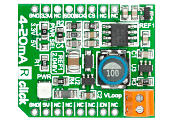
|
4-20mA R click Released

4-20mA R Click is an add-on board in mikroBUS form factor which serves as a receiver in a 4-20mA current loop standard. It features INA196 current shunt monitor, MCP3201 12-bit ADC as well as the TPS61041 DC/DC boost converter. It receives output current (4-20mA) from the transmitter and converts it into a voltage (0.4-2V). This voltage is converted into a 12-bit data signal in the MCP3201 A/D converter and sent via mikroBUS SPI lines. Together with 4-20mA T Click this board forms a complete 4-to-20mA current loop standard. It is designed to use either a 3.3V or 5V power supply.
|
2013/02/06 |

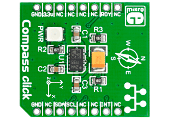
|
Compass click (Accel, Mag) Released

Compass Click is an add-on board in the mikroBUS form factor. It features the LSM303DLHC ultra-compact high-performance e-compass 3-axis magnetometer and 3-axis accelerometer module. It includes a specific sensing element and an IC interface capable of measuring both linear acceleration (full-scale of ±2g/±4g/±8g/±16g) and magnetic field (from ±1.3 to ±8.1 gauss full-scale), both in 3 dimensions, and provides a 16-bit data output through an I2C interface. By combining both a compass and an accelerometer in the same chip, magnetic north can be determined regardless of unit orientation. Readings received from the IC can be processed and used to determine earth's magnetic north pole. The board is designed to use a 3.3V power supply only. All these features make this board ideal for compensated compass, position detection, map rotation, pedometer, display orientation and many more applications.
|
2013/02/06 |


|
New Checkout System

A new checkout system has been added to the online store. To try it out simply add a few items to your basket and begin the order placement process.
If you have any comments / suggestions regarding the new system then please contact us.
|
2013/01/22 |

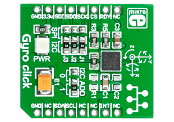
|
Gyro click (Gyroscope) Released

Gyro Click is an add-on board in the mikroBUS form factor. It features the L3GD20 three-axis digital gyroscope module, which is capable of providing the measured angular rate as well as the ambient temperature. The L3GD20 has a full scale of ±250 / ±500 / ±2000 dps and is capable of measuring rates with a user-selectable bandwidth. Gyro Click communicates with the target board microcontroller via mikroBUS SPI (MOSI, MISO, SCK, CS), I2C (SDA, SCL), INT and RST lines. The board is designed to use a 3.3V power supply only. All these features make this board ideal for gaming and virtual reality input devices, motion control, GPS navigation systems and more.
|
2013/01/16 |


|
Proteus 8 Released

Proteus Design Suite version 8 has been released. For more information on what's new in this release of Proteus, please see Labcenter's "What's New" page.
|
2013/01/15 |

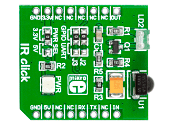
|
IR click Released

IR Click is an add-on board in the mikroBUS form factor. It is a compact and easy solution for adding an infrared (IR) remote control module to your design. It features the TSOP38338 IR receiver module as well as a QEE113 IR emitting diode. The 38 kHz receiver carrier frequency is recommended for RCMM, NEC, RC5, RC6, r-step and XMP codes. IR Click communicates with the target microcontroller via mikroBUS UART (Tx and Rx) or AN and PWM lines. Jumpers J2 and J3 allow you to choose between the two options. An SMD jumper is used to select between 3.3V or 5V power supply (soldered in 3.3V position by default).
|
2013/01/09 |


|
GSM2 click Released

GSM2 Click is a perfect solution for adding a GSM/GPRS communication layer to your device. It features the Quectel M95 GSM/GPRS module which supports GSM850MHz, GSM900MHz, DCS1800MHz or PCS1900MHz quad-band frequencies with 85.6 kbps GPRS data transfer. The board is designed in the mikroBUS form factor and contains quadrupole audio/microphone jack, SMA antenna connector and a SIM card socket. GSM Click communicates with the target microcontroller via seven mikroBUS lines (RX, TX, INT, PWM, CS, RST and AN). The board uses a 5V power supply, but can communicate at either 3.3V or 5V voltage levels (selection by SMD jumper). An LED diode indicates the presence of power supply.
|
2013/01/09 |


|
GPS2 click Released

GPS2 Click is an add-on board in the mikroBUS form factor. It includes the Quectel L30 GPS module as well as an SMA antenna connector. The module has an advanced jamming suppression mechanism and innovative RF architecture ensuring maximum GPS performance. It supports location, navigation and industrial applications including autonomous GPS C/A, SBAS (WAAS or EGNOS) and A-GPS. The board is designed for use with active antennas. SMD jumpers are provided in three groups for selecting between UART, I2C and SPI communication lines. Another SMD jumper is used to select between 3.3V or 5V power supply.
|
2013/01/09 |


|
Relay click Released

RELAY Click board features two G6D1AASI-5DC power PCB relay modules as well as two screw terminals. It communicates with the target microcontroller via mikroBUS PWM (RL1) and CS (RL2) pins. A green LED diode indicates the presence of power supply. Controls up to 5A, 250V AC/30V DC loads. The board is designed to use a 5V power supply only, however communication lines voltage level can be in the range of 1.8V to 5V as on-board transistors are used to drive the relays by current sinking.
|
2013/01/04 |


|
Mini-M4 for STM32 Released

MINI-M4 for STM32 is a small ARM Cortex-M4 development board containing the STM32F415RG microcontroller. It is pin compatible with the PIC16F887 and PIC18(L)F45K20 microcontrontrollers and it perfectly fits into a standard DIP40 socket. The board is equipped with a 16MHz SMD crystal oscillator, as well as a 32.768KHz crystal which can be used for the internal RTCC module. It has a reset button and three signal LEDs. The board comes preprogrammed with fast USB HID bootloader, so no external programmers are needed for development. It operates on a 3.3V power supply. An on-board voltage regulator allows the board to be powered directly from the USB cable.
|
2012/11/30 |


|
Mini-M4 for Stellaris Released

MINI-M4 for Stellaris is a small ARM Cortex-M4 development board containing the LX4F320H5QR microcontroller. It is pin compatible with the PIC16F887 and PIC18(L)F45K20 microcontrontrollers and it perfectly fits into a standard DIP40 socket. The board is equipped with a 16MHz SMD crystal oscillator, as well as a 32.768KHz crystal which can be used for the internal RTCC module. It has a reset button and three signal LEDs. The board comes preprogrammed with fast USB HID bootloader, so no external programmers are needed for development. It operates on a 3.3V power supply. An on-board voltage regulator allows the board to be powered directly from the USB cable.
|
2012/11/30 |

|

